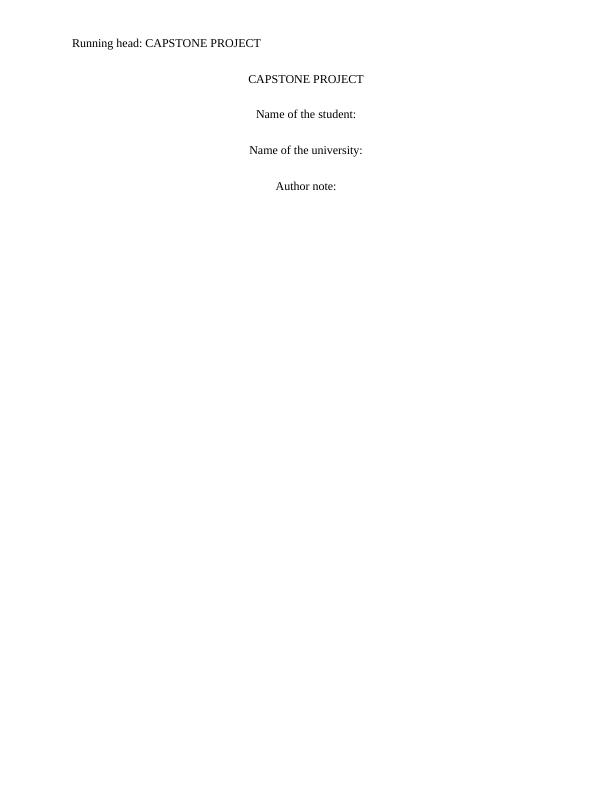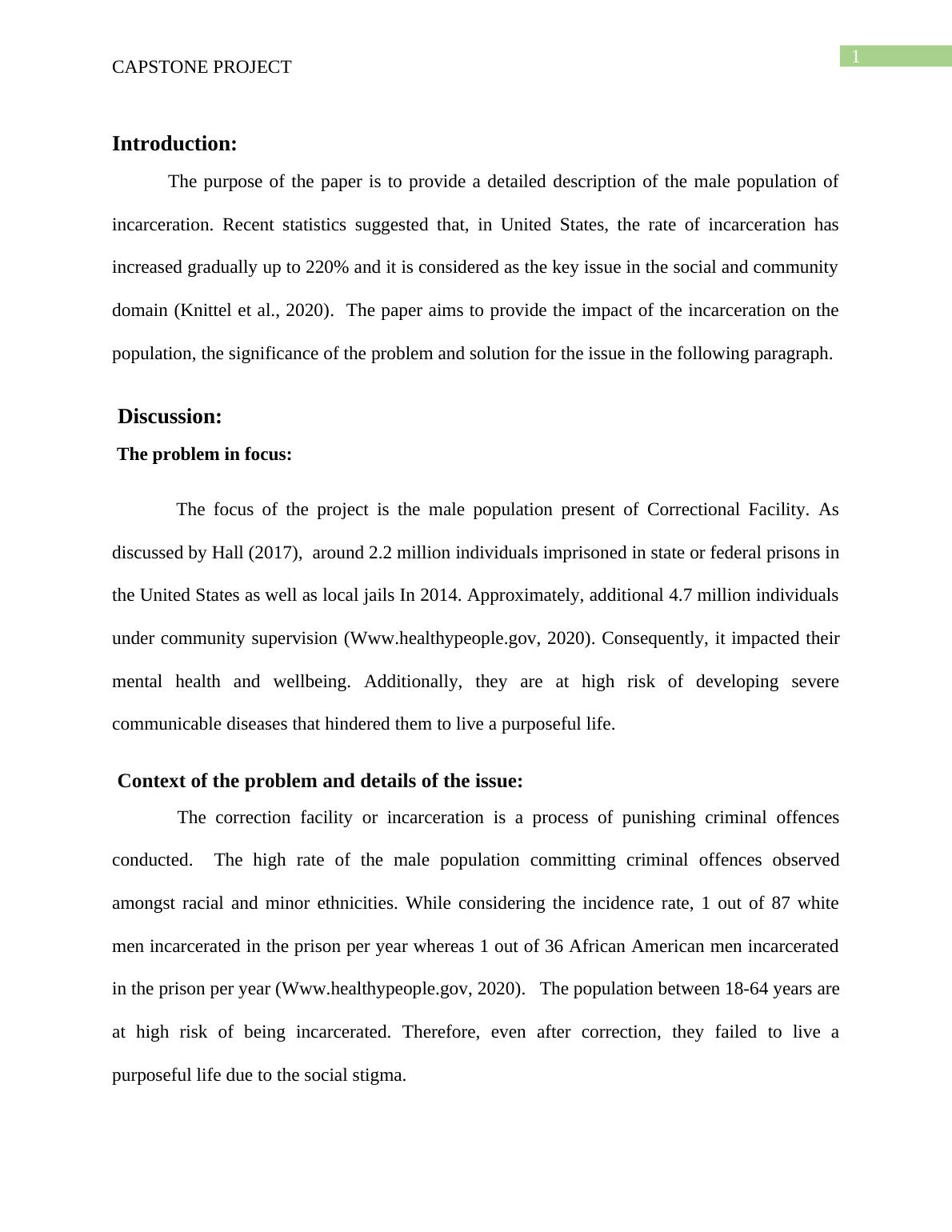Capstone Project Research Paper 2022
Added on 2022-09-18
6 Pages1090 Words40 Views
Running head: CAPSTONE PROJECT
CAPSTONE PROJECT
Name of the student:
Name of the university:
Author note:
CAPSTONE PROJECT
Name of the student:
Name of the university:
Author note:

1
CAPSTONE PROJECT
Introduction:
The purpose of the paper is to provide a detailed description of the male population of
incarceration. Recent statistics suggested that, in United States, the rate of incarceration has
increased gradually up to 220% and it is considered as the key issue in the social and community
domain (Knittel et al., 2020). The paper aims to provide the impact of the incarceration on the
population, the significance of the problem and solution for the issue in the following paragraph.
Discussion:
The problem in focus:
The focus of the project is the male population present of Correctional Facility. As
discussed by Hall (2017), around 2.2 million individuals imprisoned in state or federal prisons in
the United States as well as local jails In 2014. Approximately, additional 4.7 million individuals
under community supervision (Www.healthypeople.gov, 2020). Consequently, it impacted their
mental health and wellbeing. Additionally, they are at high risk of developing severe
communicable diseases that hindered them to live a purposeful life.
Context of the problem and details of the issue:
The correction facility or incarceration is a process of punishing criminal offences
conducted. The high rate of the male population committing criminal offences observed
amongst racial and minor ethnicities. While considering the incidence rate, 1 out of 87 white
men incarcerated in the prison per year whereas 1 out of 36 African American men incarcerated
in the prison per year (Www.healthypeople.gov, 2020). The population between 18-64 years are
at high risk of being incarcerated. Therefore, even after correction, they failed to live a
purposeful life due to the social stigma.
CAPSTONE PROJECT
Introduction:
The purpose of the paper is to provide a detailed description of the male population of
incarceration. Recent statistics suggested that, in United States, the rate of incarceration has
increased gradually up to 220% and it is considered as the key issue in the social and community
domain (Knittel et al., 2020). The paper aims to provide the impact of the incarceration on the
population, the significance of the problem and solution for the issue in the following paragraph.
Discussion:
The problem in focus:
The focus of the project is the male population present of Correctional Facility. As
discussed by Hall (2017), around 2.2 million individuals imprisoned in state or federal prisons in
the United States as well as local jails In 2014. Approximately, additional 4.7 million individuals
under community supervision (Www.healthypeople.gov, 2020). Consequently, it impacted their
mental health and wellbeing. Additionally, they are at high risk of developing severe
communicable diseases that hindered them to live a purposeful life.
Context of the problem and details of the issue:
The correction facility or incarceration is a process of punishing criminal offences
conducted. The high rate of the male population committing criminal offences observed
amongst racial and minor ethnicities. While considering the incidence rate, 1 out of 87 white
men incarcerated in the prison per year whereas 1 out of 36 African American men incarcerated
in the prison per year (Www.healthypeople.gov, 2020). The population between 18-64 years are
at high risk of being incarcerated. Therefore, even after correction, they failed to live a
purposeful life due to the social stigma.

2
CAPSTONE PROJECT
As discussed above the population between 18-64 years are at high risk of being
incarcerated. The population with a lack of education, history of drug abuse and lack of
employment often inclined to commit crimes which resulted in frequent arrest and incarceration
(Nowotny et al., 2020). The population after correct are at risk of developing mental illness such
as depression, anxiety and post-traumatic stress disorder as they do not receive adequate services
while in prison (Ross et al., 2018). They also commit suicide due to the negligence of the
community and family members.
Impact of the problem on environment, quality of care and patient outcome:
The impact of incarceration is that the male population often experience mental illness,
exhibit aggression and violence while receiving care. They often exhibit anger which made it
challenging for the professionals to work in the facility to provide care (Ross et al., 2018). It has
poor patient outcome as professionals failed to provide quality of care due to the lived
experience they subjected to (Daniels, 2016).
Significance of the issue and nursing implication:
The significance of the issue is that the male population often experience trauma after
incarceration which resulted in poor reintegration with the society (Ross et al., 2018). They often
experience abuse, negligence from the family members which resulted in poor mental health.
Within the correction facility, they do not receive adequate treatment to correct behaviour
(Www.healthypeople.gov, 2020). The implication in nursing is that it will enable nurses to
provide the best possible care to the male population within in correction facility.
Strategy:
The common strategy to mitigate such an issue is to develop a drug treatment court,
awareness program which will reduce the incarceration rate and drug
CAPSTONE PROJECT
As discussed above the population between 18-64 years are at high risk of being
incarcerated. The population with a lack of education, history of drug abuse and lack of
employment often inclined to commit crimes which resulted in frequent arrest and incarceration
(Nowotny et al., 2020). The population after correct are at risk of developing mental illness such
as depression, anxiety and post-traumatic stress disorder as they do not receive adequate services
while in prison (Ross et al., 2018). They also commit suicide due to the negligence of the
community and family members.
Impact of the problem on environment, quality of care and patient outcome:
The impact of incarceration is that the male population often experience mental illness,
exhibit aggression and violence while receiving care. They often exhibit anger which made it
challenging for the professionals to work in the facility to provide care (Ross et al., 2018). It has
poor patient outcome as professionals failed to provide quality of care due to the lived
experience they subjected to (Daniels, 2016).
Significance of the issue and nursing implication:
The significance of the issue is that the male population often experience trauma after
incarceration which resulted in poor reintegration with the society (Ross et al., 2018). They often
experience abuse, negligence from the family members which resulted in poor mental health.
Within the correction facility, they do not receive adequate treatment to correct behaviour
(Www.healthypeople.gov, 2020). The implication in nursing is that it will enable nurses to
provide the best possible care to the male population within in correction facility.
Strategy:
The common strategy to mitigate such an issue is to develop a drug treatment court,
awareness program which will reduce the incarceration rate and drug

End of preview
Want to access all the pages? Upload your documents or become a member.
Related Documents
The Picot Statement Case Study 2022lg...
|5
|565
|24
Special Population in Correctional Facilities: Issues and Needslg...
|14
|1215
|93
Forensic Mental Health and Professional Boundarieslg...
|9
|2210
|277
Managing a Suicidal Patient | Reportlg...
|14
|3525
|21
